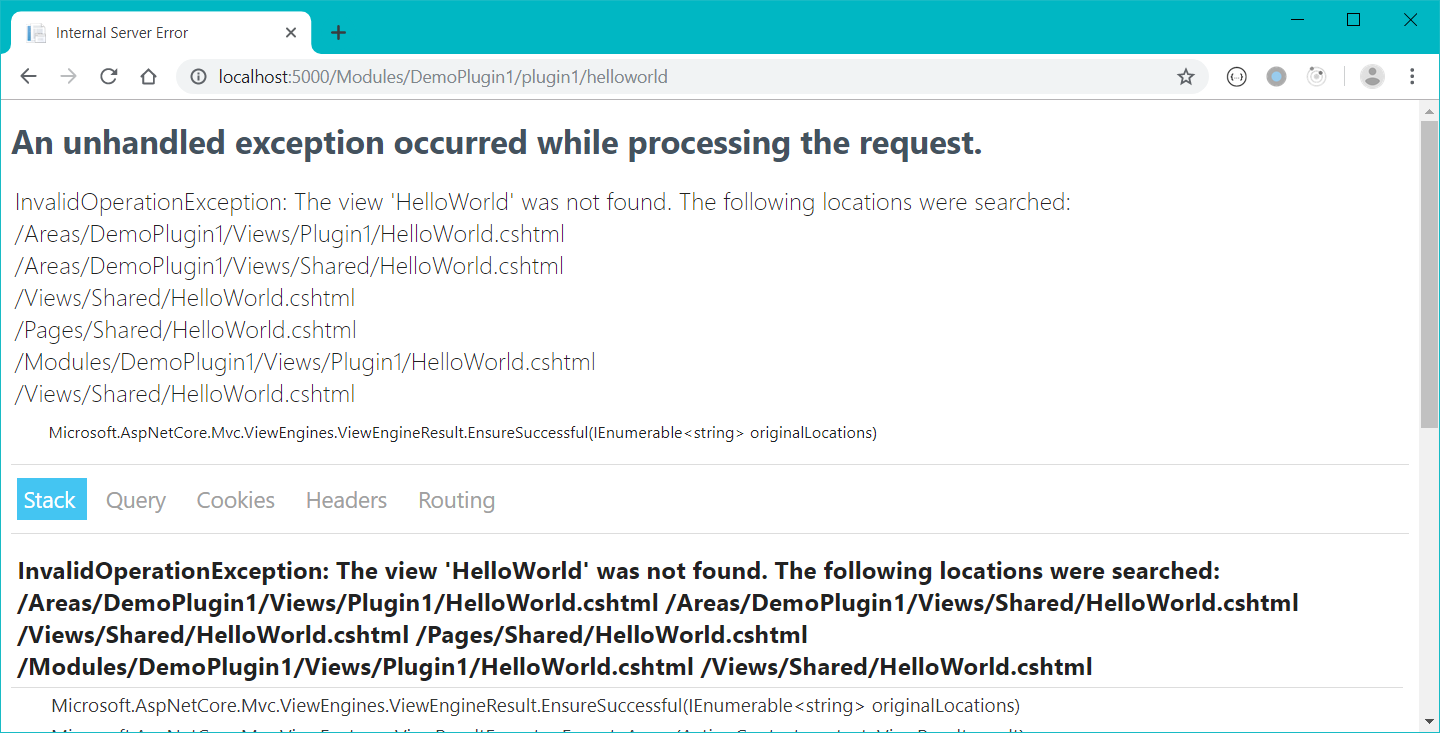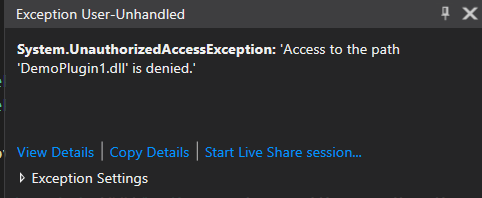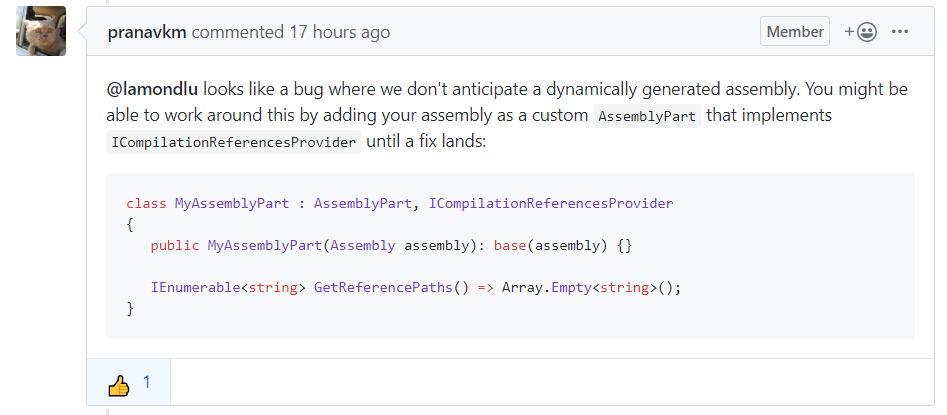来源: 从零开始实现ASP.NET Core MVC的插件式开发(五) – 插件的删除和升级 – LamondLu – 博客园
系列文章
- 从零开始实现ASP.NET Core MVC的插件式开发(一) – 使用Application Part动态加载控制器和视图
- 从零开始实现ASP.NET Core MVC的插件式开发(二) – 如何创建项目模板
- 从零开始实现ASP.NET Core MVC的插件式开发(三) – 如何在运行时启用组件
- 从零开始实现ASP.NET Core MVC的插件式开发(四) – 插件安装
- 从零开始实现ASP.NET Core MVC的插件式开发(五) – 使用AssemblyLoadContext实现插件的升级和删除
- 从零开始实现ASP.NET Core MVC的插件式开发(六) – 如何加载插件引用
- 从零开始实现ASP.NET Core MVC的插件式开发(七) – 近期问题汇总及部分解决方案
- 从零开始实现ASP.NET Core MVC的插件式开发(八) – Razor视图相关问题及解决方案
简介
在上一篇中,我为大家讲解了如何实现插件的安装,在文章的最后,留下了两个待解决的问题。
- .NET Core 2.2中不能实现运行时删除插件
- .NET Core 2.2中不能实现运行时升级插件
其实这2个问题归根结底其实都是一个问题,就是插件程序集被占用,不能在运行时更换程序集。在本篇中,我将分享一下我是如何一步一步解决这个问题的,其中也绕了不少弯路,查阅过资料,在.NET Core官方提过Bug,几次差点想放弃了,不过最终是找到一个可行的方案。
.NET Core 2.2的遗留问题
程序集被占用的原因#
回顾一下,我们之前加载插件程序集时所有使用的代码。
var provider = services.BuildServiceProvider();
using (var scope = provider.CreateScope())
{
var unitOfWork = scope.ServiceProvider.GetService<IUnitOfWork>();
var allEnabledPlugins = unitOfWork.PluginRepository
.GetAllEnabledPlugins();
foreach (var plugin in allEnabledPlugins)
{
var moduleName = plugin.Name;
var assembly = Assembly.LoadFile($"{AppDomain.CurrentDomain.BaseDirectory}Modules\\{moduleName}\\{moduleName}.dll");
var controllerAssemblyPart = new AssemblyPart(assembly);
mvcBuilders.PartManager
.ApplicationParts
.Add(controllerAssemblyPart);
}
}
这里我们使用了Assembly.LoadFile方法加载了插件程序集。 在.NET中使用Assembly.LoadFile方法加载的程序集会被自动锁定,不能执行任何转移,删除等造作,所以这就给我们删除和升级插件造成了很大困难。
PS: 升级插件需要覆盖已加载的插件程序集,由于程序集锁定,所以覆盖操作不能成功。
使用AssemblyLoadContext#
在.NET Framework中,如果遇到这个问题,常用的解决方案是使用AppDomain类来实现插件热插拔,但是在.NET Core中没有AppDomain类。不过经过查阅,.NET Core 2.0之后引入了一个AssemblyLoadContext类来替代.NET Freamwork中的AppDomain。本以为使用它就能解决当前程序集占用的问题,结果没想到.NET Core 2.x版本提供的AssemblyLoadContext没有提供Unload方法来释放加载的程序集,只有在.NET Core 3.0版本中才为AssemblyLoadContext类添加了Unload方法。
相关链接:
升级.NET Core 3.0 Preview 8
因此,为了完成插件的删除和升级功能,我将整个项目升级到了最新的.NET Core 3.0 Preview 8版本。
这里.NET Core 2.2升级到.NET Core 3.0有一点需要注意的问题。
在.NET Core 2.2中默认启用了Razor视图的运行时编译,简单点说就是.NET Core 2.2中自动启用了读取原始的Razor视图文件,并编译视图的功能。这就是我们在第三章和第四章中的实现方法,每个插件文件最终都放置在了一个Modules目录中,每个插件既有包含Controller/Action的程序集,又有对应的原始Razor视图目录Views,在.NET Core 2.2中当我们在运行时启用一个组件之后,对应的Views可以自动加载。
The files tree is:
=================
|__ DynamicPlugins.Core.dll
|__ DynamicPlugins.Core.pdb
|__ DynamicPluginsDemoSite.deps.json
|__ DynamicPluginsDemoSite.dll
|__ DynamicPluginsDemoSite.pdb
|__ DynamicPluginsDemoSite.runtimeconfig.dev.json
|__ DynamicPluginsDemoSite.runtimeconfig.json
|__ DynamicPluginsDemoSite.Views.dll
|__ DynamicPluginsDemoSite.Views.pdb
|__ Modules
|__ DemoPlugin1
|__ DemoPlugin1.dll
|__ Views
|__ Plugin1
|__ HelloWorld.cshtml
|__ _ViewStart.cshtml
但是在.NET Core 3.0中,Razor视图的运行时编译需要引入程序集Microsoft.AspNetCore.Mvc.Razor.RuntimeCompilation。并且在程序启动时,需要启动运行时编译的功能。
public void ConfigureServices(IServiceCollection services)
{
...
var mvcBuilders = services.AddMvc()
.AddRazorRuntimeCompilation();
...
}
如果没有启用Razor视图的运行时编译,程序访问插件视图的时候,就会报错,提示视图找不到。
使用.NET Core 3.0的AssemblyLoadContext加载程序集#
这里为了创建一个可回收的程序集加载上下文,我们首先基于AssemblyLoadcontext创建一个CollectibleAssemblyLoadContext类。其中我们将IsCollectible属性通过父类构造函数,将其设置为true。
public class CollectibleAssemblyLoadContext
: AssemblyLoadContext
{
public CollectibleAssemblyLoadContext()
: base(isCollectible: true)
{
}
protected override Assembly Load(AssemblyName name)
{
return null;
}
}
在整个插件加载上下文的设计上,每个插件都使用一个单独的CollectibleAssemblyLoadContext来加载,所有插件的CollectibleAssemblyLoadContext都放在一个PluginsLoadContext对象中。
相关代码: PluginsLoadContexts.cs
public static class PluginsLoadContexts
{
private static Dictionary<string, CollectibleAssemblyLoadContext>
_pluginContexts = null;
static PluginsLoadContexts()
{
_pluginContexts = new Dictionary<string, CollectibleAssemblyLoadContext>();
}
public static bool Any(string pluginName)
{
return _pluginContexts.ContainsKey(pluginName);
}
public static void RemovePluginContext(string pluginName)
{
if (_pluginContexts.ContainsKey(pluginName))
{
_pluginContexts[pluginName].Unload();
_pluginContexts.Remove(pluginName);
}
}
public static CollectibleAssemblyLoadContext GetContext(string pluginName)
{
return _pluginContexts[pluginName];
}
public static void AddPluginContext(string pluginName,
CollectibleAssemblyLoadContext context)
{
_pluginContexts.Add(pluginName, context);
}
}
代码解释:
- 当加载插件的时候,我们需要将当前插件的程序集加载上下文放到
_pluginContexts字典中。字典的key是插件的名称,字典的value是插件的程序集加载上下文。 - 当移除一个插件的时候,我们需要使用
Unload方法,来释放当前的程序集加载上下文。
在完成以上代码之后,我们更改程序启动和启用组件的代码,因为这两部分都需要将插件程序集加载到CollectibleAssemblyLoadContext中。
Startup.cs
var provider = services.BuildServiceProvider();
using (var scope = provider.CreateScope())
{
var option = scope.ServiceProvider
.GetService<MvcRazorRuntimeCompilationOptions>();
var unitOfWork = scope.ServiceProvider
.GetService<IUnitOfWork>();
var allEnabledPlugins = unitOfWork.PluginRepository
.GetAllEnabledPlugins();
foreach (var plugin in allEnabledPlugins)
{
var context = new CollectibleAssemblyLoadContext();
var moduleName = plugin.Name;
var filePath = $"{AppDomain.CurrentDomain.BaseDirectory}Modules\\{moduleName}\\{moduleName}.dll";
var assembly = context.LoadFromAssemblyPath(filePath);
var controllerAssemblyPart = new AssemblyPart(assembly);
mvcBuilders.PartManager.ApplicationParts
.Add(controllerAssemblyPart);
PluginsLoadContexts.AddPluginContext(plugin.Name, context);
}
}
PluginsController.cs
public IActionResult Enable(Guid id)
{
var module = _pluginManager.GetPlugin(id);
if (!PluginsLoadContexts.Any(module.Name))
{
var context = new CollectibleAssemblyLoadContext();
_pluginManager.EnablePlugin(id);
var moduleName = module.Name;
var filePath = $"{AppDomain.CurrentDomain.BaseDirectory}Modules\\{moduleName}\\{moduleName}.dll";
context.
var assembly = context.LoadFromAssemblyPath(filePath);
var controllerAssemblyPart = new AssemblyPart(assembly);
_partManager.ApplicationParts.Add(controllerAssemblyPart);
MyActionDescriptorChangeProvider.Instance.HasChanged = true;
MyActionDescriptorChangeProvider.Instance.TokenSource.Cancel();
PluginsLoadContexts.AddPluginContext(module.Name, context);
}
else
{
var context = PluginsLoadContexts.GetContext(module.Name);
var controllerAssemblyPart = new AssemblyPart(context.Assemblies.First());
_partManager.ApplicationParts.Add(controllerAssemblyPart);
_pluginManager.EnablePlugin(id);
MyActionDescriptorChangeProvider.Instance.HasChanged = true;
MyActionDescriptorChangeProvider.Instance.TokenSource.Cancel();
}
return RedirectToAction("Index");
}
意外结果#
完成以上代码之后,我立刻尝试了删除程序集的操作,但是得到的结果却不是我想要的。
虽然.NET Core 3.0为AssemblyLoadContext提供了Unload方法,但是调用之后, 你依然会得到一个文件被占用的错误
暂时不知道这是不是.NET Core 3.0的bug, 还是功能就是这么设计的,反正感觉这条路是走不通了,折腾了一天,在网上找了好多方案,但是都不能解决这个问题。
就在快放弃的时候,突然发现AssemblyLoadContext类提供了另外一种加载程序集的方式LoadFromStream。
改用LoadFromStream加载程序集#
看到LoadFromStream方法之后,我的第一思路就是可以使用FileStream加载插件程序集,然后将获得的文件流传给LoadFromStream方法,并在文件加载完毕之后,释放掉这个FileStream对象。
根据以上思路,我将加载程序集的方法修改如下
PS: Enable方法的修改方式类似,这里我就不重复写了。
var provider = services.BuildServiceProvider();
using (var scope = provider.CreateScope())
{
var option = scope.ServiceProvider
.GetService<MvcRazorRuntimeCompilationOptions>();
var unitOfWork = scope.ServiceProvider.GetService<IUnitOfWork>();
var allEnabledPlugins = unitOfWork.PluginRepository.GetAllEnabledPlugins();
foreach (var plugin in allEnabledPlugins)
{
var context = new CollectibleAssemblyLoadContext();
var moduleName = plugin.Name;
var filePath = $"{AppDomain.CurrentDomain.BaseDirectory}Modules\\{moduleName}\\{moduleName}.dll";
_presetReferencePaths.Add(filePath);
using (var fs = new FileStream(filePath, FileMode.Open))
{
var assembly = context.LoadFromStream(fs);
var controllerAssemblyPart = new AssemblyPart(assembly);
mvcBuilders.PartManager.ApplicationParts.Add(controllerAssemblyPart);
PluginsLoadContexts.AddPluginContext(plugin.Name, context);
}
}
}
修改之后,我又试了一下删除插件的代码,果然成功删除了。
“Empty path name is not legal. “问题#
就在我认为功能已经全部完成之后,我又重新安装了删除的插件,尝试访问插件中的controller/action, 结果得到了意想不到的错误,插件的中包含的页面打不开了。
fail: Microsoft.AspNetCore.Diagnostics.ExceptionHandlerMiddleware[1]
An unhandled exception has occurred while executing the request.
System.ArgumentException: Empty path name is not legal. (Parameter 'path')
at System.IO.FileStream..ctor(String path, FileMode mode, FileAccess access, FileShare share, Int32 bufferSize, FileOptions options)
at Microsoft.AspNetCore.Mvc.Razor.RuntimeCompilation.RazorReferenceManager.CreateMetadataReference(String path)
at System.Linq.Enumerable.SelectListIterator`2.ToList()
at System.Linq.Enumerable.ToList[TSource](IEnumerable`1 source)
at Microsoft.AspNetCore.Mvc.Razor.RuntimeCompilation.RazorReferenceManager.GetCompilationReferences()
at System.Threading.LazyInitializer.EnsureInitializedCore[T](T& target, Boolean& initialized, Object& syncLock, Func`1 valueFactory)
at System.Threading.LazyInitializer.EnsureInitialized[T](T& target, Boolean& initialized, Object& syncLock, Func`1 valueFactory)
at Microsoft.AspNetCore.Mvc.Razor.RuntimeCompilation.RazorReferenceManager.get_CompilationReferences()
at Microsoft.AspNetCore.Mvc.Razor.RuntimeCompilation.LazyMetadataReferenceFeature.get_References()
at Microsoft.CodeAnalysis.Razor.CompilationTagHelperFeature.GetDescriptors()
at Microsoft.AspNetCore.Razor.Language.DefaultRazorTagHelperBinderPhase.ExecuteCore(RazorCodeDocument codeDocument)
at Microsoft.AspNetCore.Razor.Language.RazorEnginePhaseBase.Execute(RazorCodeDocument codeDocument)
at Microsoft.AspNetCore.Razor.Language.DefaultRazorEngine.Process(RazorCodeDocument document)
at Microsoft.AspNetCore.Razor.Language.DefaultRazorProjectEngine.ProcessCore(RazorCodeDocument codeDocument)
at Microsoft.AspNetCore.Razor.Language.RazorProjectEngine.Process(RazorProjectItem projectItem)
at Microsoft.AspNetCore.Mvc.Razor.RuntimeCompilation.RuntimeViewCompiler.CompileAndEmit(String relativePath)
at Microsoft.AspNetCore.Mvc.Razor.RuntimeCompilation.RuntimeViewCompiler.OnCacheMiss(String normalizedPath)
--- End of stack trace from previous location where exception was thrown ---
at Microsoft.AspNetCore.Mvc.Razor.Compilation.DefaultRazorPageFactoryProvider.CreateFactory(String relativePath)
at Microsoft.AspNetCore.Mvc.Razor.RazorViewEngine.CreateCacheResult(HashSet`1 expirationTokens, String relativePath, Boolean isMainPage)
at Microsoft.AspNetCore.Mvc.Razor.RazorViewEngine.OnCacheMiss(ViewLocationExpanderContext expanderContext, ViewLocationCacheKey cacheKey)
at Microsoft.AspNetCore.Mvc.Razor.RazorViewEngine.LocatePageFromViewLocations(ActionContext actionContext, String pageName, Boolean isMainPage)
at Microsoft.AspNetCore.Mvc.Razor.RazorViewEngine.FindView(ActionContext context, String viewName, Boolean isMainPage)
at Microsoft.AspNetCore.Mvc.ViewEngines.CompositeViewEngine.FindView(ActionContext context, String viewName, Boolean isMainPage)
at Microsoft.AspNetCore.Mvc.ViewFeatures.ViewResultExecutor.FindView(ActionContext actionContext, ViewResult viewResult)
at Microsoft.AspNetCore.Mvc.ViewFeatures.ViewResultExecutor.ExecuteAsync(ActionContext context, ViewResult result)
at Microsoft.AspNetCore.Mvc.ViewResult.ExecuteResultAsync(ActionContext context)
at Microsoft.AspNetCore.Mvc.Infrastructure.ResourceInvoker.<InvokeNextResultFilterAsync>g__Awaited|29_0[TFilter,TFilterAsync](ResourceInvoker invoker, Task lastTask, State next, Scope scope, Object state, Boolean isCompleted)
at Microsoft.AspNetCore.Mvc.Infrastructure.ResourceInvoker.Rethrow(ResultExecutedContextSealed context)
at Microsoft.AspNetCore.Mvc.Infrastructure.ResourceInvoker.ResultNext[TFilter,TFilterAsync](State& next, Scope& scope, Object& state, Boolean& isCompleted)
at Microsoft.AspNetCore.Mvc.Infrastructure.ResourceInvoker.InvokeResultFilters()
--- End of stack trace from previous location where exception was thrown ---
at Microsoft.AspNetCore.Mvc.Infrastructure.ResourceInvoker.<InvokeNextResourceFilter>g__Awaited|24_0(ResourceInvoker invoker, Task lastTask, State next, Scope scope, Object state, Boolean isCompleted)
at Microsoft.AspNetCore.Mvc.Infrastructure.ResourceInvoker.Rethrow(ResourceExecutedContextSealed context)
at Microsoft.AspNetCore.Mvc.Infrastructure.ResourceInvoker.Next(State& next, Scope& scope, Object& state, Boolean& isCompleted)
at Microsoft.AspNetCore.Mvc.Infrastructure.ResourceInvoker.InvokeFilterPipelineAsync()
--- End of stack trace from previous location where exception was thrown ---
at Microsoft.AspNetCore.Mvc.Infrastructure.ResourceInvoker.<InvokeAsync>g__Awaited|17_0(ResourceInvoker invoker, Task task, IDisposable scope)
at Microsoft.AspNetCore.Routing.EndpointMiddleware.<Invoke>g__AwaitRequestTask|6_0(Endpoint endpoint, Task requestTask, ILogger logger)
at Microsoft.AspNetCore.Routing.EndpointRoutingMiddleware.SetRoutingAndContinue(HttpContext httpContext)
at Microsoft.AspNetCore.Diagnostics.ExceptionHandlerMiddleware.<Invoke>g__Awaited|6_0(ExceptionHandlerMiddleware middleware, HttpContext context, Task task)
这个文件路径非法的错误让我感觉很奇怪,为什么会有这种问题呢?与之前的代码的不同之处只有一个地方,就是从LoadFromAssemblyPath改为了LoadFromStream。
为了弄清这个问题,我clone了最新的.NET Core 3.0 Preview 8源代码,发现了在 .NET Core运行时编译视图的时候,会调用如下方法。
RazorReferenceManager.cs
internal IEnumerable<string> GetReferencePaths()
{
var referencePaths = new List<string>();
foreach (var part in _partManager.ApplicationParts)
{
if (part is ICompilationReferencesProvider compilationReferenceProvider)
{
referencePaths.AddRange(compilationReferenceProvider.GetReferencePaths());
}
else if (part is AssemblyPart assemblyPart)
{
referencePaths.AddRange(assemblyPart.GetReferencePaths());
}
}
referencePaths.AddRange(_options.AdditionalReferencePaths);
return referencePaths;
}
这段代码意思是根据当前加载程序集的所在位置,来发现对应视图。
那么问题就显而易见了,我们之前用LoadFromAssemblyPath加载程序集,程序集的文件位置被自动记录下来,但是我们改用LoadFromStream之后,所需的文件位置信息丢失了,是一个空字符串,所以.NET Core在尝试加载视图的时候,遇到空字符串,抛出了一个非法路径的错误。
其实这里的方法很好改,只需要将空字符串的路径排除掉即可。
internal IEnumerable<string> GetReferencePaths()
{
var referencePaths = new List<string>();
foreach (var part in _partManager.ApplicationParts)
{
if (part is ICompilationReferencesProvider compilationReferenceProvider)
{
referencePaths.AddRange(compilationReferenceProvider.GetReferencePaths());
}
else if (part is AssemblyPart assemblyPart)
{
referencePaths.AddRange(assemblyPart.GetReferencePaths().Where(o => !string.IsNullOrEmpty(o));
}
}
referencePaths.AddRange(_options.AdditionalReferencePaths);
return referencePaths;
}
但是由于不清楚会不会导致其他问题,所以我没有采取这种方法,我将这个问题作为一个Bug提交到了官方。
没想到仅仅8小时,就得到官方的解决方案。
这段意思是说ASP.NET Core暂时不支持动态加载程序集,如果要在当前版本实现功能,需要自己实现一个AssemblyPart类, 在获取程序集路径的时候,返回空集合而不是空字符串。
PS: 官方已经将这个问题放到了.NET 5 Preview 1中,相信.NET 5中会得到真正的解决。
根据官方的方案,Startup.cs文件的最终版本
public class MyAssemblyPart : AssemblyPart, ICompilationReferencesProvider
{
public MyAssemblyPart(Assembly assembly) : base(assembly) { }
public IEnumerable<string> GetReferencePaths() => Array.Empty<string>();
}
public static class AdditionalReferencePathHolder
{
public static IList<string> AdditionalReferencePaths = new List<string>();
}
public class Startup
{
public IList<string> _presets = new List<string>();
public Startup(IConfiguration configuration)
{
Configuration = configuration;
}
public IConfiguration Configuration { get; }
// This method gets called by the runtime. Use this method to add services to the container.
public void ConfigureServices(IServiceCollection services)
{
services.AddOptions();
services.Configure<ConnectionStringSetting>(Configuration.GetSection("ConnectionStringSetting"));
services.AddScoped<IPluginManager, PluginManager>();
services.AddScoped<IUnitOfWork, UnitOfWork>();
var mvcBuilders = services.AddMvc()
.AddRazorRuntimeCompilation(o =>
{
foreach (var item in _presets)
{
o.AdditionalReferencePaths.Add(item);
}
AdditionalReferencePathHolder.AdditionalReferencePaths = o.AdditionalReferencePaths;
});
services.Configure<RazorViewEngineOptions>(o =>
{
o.AreaViewLocationFormats.Add("/Modules/{2}/Views/{1}/{0}" + RazorViewEngine.ViewExtension);
o.AreaViewLocationFormats.Add("/Views/Shared/{0}.cshtml");
});
services.AddSingleton<IActionDescriptorChangeProvider>(MyActionDescriptorChangeProvider.Instance);
services.AddSingleton(MyActionDescriptorChangeProvider.Instance);
var provider = services.BuildServiceProvider();
using (var scope = provider.CreateScope())
{
var option = scope.ServiceProvider.GetService<MvcRazorRuntimeCompilationOptions>();
var unitOfWork = scope.ServiceProvider.GetService<IUnitOfWork>();
var allEnabledPlugins = unitOfWork.PluginRepository.GetAllEnabledPlugins();
foreach (var plugin in allEnabledPlugins)
{
var context = new CollectibleAssemblyLoadContext();
var moduleName = plugin.Name;
var filePath = $"{AppDomain.CurrentDomain.BaseDirectory}Modules\\{moduleName}\\{moduleName}.dll";
_presets.Add(filePath);
using (var fs = new FileStream(filePath, FileMode.Open))
{
var assembly = context.LoadFromStream(fs);
var controllerAssemblyPart = new MyAssemblyPart(assembly);
mvcBuilders.PartManager.ApplicationParts.Add(controllerAssemblyPart);
PluginsLoadContexts.AddPluginContext(plugin.Name, context);
}
}
}
}
public void Configure(IApplicationBuilder app, IWebHostEnvironment env)
{
if (env.IsDevelopment())
{
app.UseDeveloperExceptionPage();
}
else
{
app.UseExceptionHandler("/Home/Error");
}
app.UseStaticFiles();
app.UseRouting();
app.UseEndpoints(routes =>
{
routes.MapControllerRoute(
name: "Customer",
pattern: "{controller=Home}/{action=Index}/{id?}");
routes.MapControllerRoute(
name: "Customer",
pattern: "Modules/{area}/{controller=Home}/{action=Index}/{id?}");
});
}
}
插件删除和升级的代码
解决了程序集占用问题之后,我们就可以开始编写删除/升级插件的代码了。
删除插件#
如果要删除一个插件,我们需要完成以下几个步骤
- 删除组件记录
- 删除组件迁移的表结构
- 移除加载过的ApplicationPart
- 刷新Controller/Action
- 移除组件对应的程序集加载上下文
- 删除组件文件
根据这个步骤,我编写了一个Delete方法,代码如下:
public IActionResult Delete(Guid id)
{
var module = _pluginManager.GetPlugin(id);
_pluginManager.DisablePlugin(id);
_pluginManager.DeletePlugin(id);
var moduleName = module.Name;
var matchedItem = _partManager.ApplicationParts.FirstOrDefault(p =>
p.Name == moduleName);
if (matchedItem != null)
{
_partManager.ApplicationParts.Remove(matchedItem);
matchedItem = null;
}
MyActionDescriptorChangeProvider.Instance.HasChanged = true;
MyActionDescriptorChangeProvider.Instance.TokenSource.Cancel();
PluginsLoadContexts.RemovePluginContext(module.Name);
var directory = new DirectoryInfo($"{AppDomain.CurrentDomain.BaseDirectory}Modules/{module.Name}");
directory.Delete(true);
return RedirectToAction("Index");
}
升级插件#
对于升级插件的代码,我将它和新增插件的代码放在了一起
public void AddPlugins(PluginPackage pluginPackage)
{
var existedPlugin = _unitOfWork.PluginRepository.GetPlugin(pluginPackage.Configuration.Name);
if (existedPlugin == null)
{
InitializePlugin(pluginPackage);
}
else if (new DomainModel.Version(pluginPackage.Configuration.Version) > new DomainModel.Version(existedPlugin.Version))
{
UpgradePlugin(pluginPackage, existedPlugin);
}
else
{
DegradePlugin(pluginPackage);
}
}
private void InitializePlugin(PluginPackage pluginPackage)
{
var plugin = new DTOs.AddPluginDTO
{
Name = pluginPackage.Configuration.Name,
DisplayName = pluginPackage.Configuration.DisplayName,
PluginId = Guid.NewGuid(),
UniqueKey = pluginPackage.Configuration.UniqueKey,
Version = pluginPackage.Configuration.Version
};
_unitOfWork.PluginRepository.AddPlugin(plugin);
_unitOfWork.Commit();
var versions = pluginPackage.GetAllMigrations(_connectionString);
foreach (var version in versions)
{
version.MigrationUp(plugin.PluginId);
}
pluginPackage.SetupFolder();
}
public void UpgradePlugin(PluginPackage pluginPackage, PluginViewModel oldPlugin)
{
_unitOfWork.PluginRepository.UpdatePluginVersion(oldPlugin.PluginId,
pluginPackage.Configuration.Version);
_unitOfWork.Commit();
var migrations = pluginPackage.GetAllMigrations(_connectionString);
var pendingMigrations = migrations.Where(p => p.Version > oldPlugin.Version);
foreach (var migration in pendingMigrations)
{
migration.MigrationUp(oldPlugin.PluginId);
}
pluginPackage.SetupFolder();
}
public void DegradePlugin(PluginPackage pluginPackage)
{
throw new NotImplementedException();
}
代码解释:
- 这里我首先判断了当前插件包和已安装版本的版本差异
- 如果系统没有安装过当前插件,就安装插件
- 如果当前插件包的版本比已安装的版本高,就升级插件
- 如果当前插件包的版本比已安装的版本低,就降级插件(现实中这种情况不多)
InitializePlugin是用来加载新组件的,它的内容就是之前的新增插件方法UpgradePlugin是用来升级组件的,当我们升级一个组件的时候,我们需要做一下几个事情- 升级组件版本
- 做最新版本组件的脚本迁移
- 使用最新程序包覆盖老程序包
DegradePlugin是用来降级组件的,由于篇幅问题,我就不详细写了,大家可以自行填补。
最终效果
总结
本篇中,我为大家演示如果使用.NET Core 3.0的AssemblyLoadContext来解决已加载程序集占用的问题,以此实现了插件的升级和降级。本篇的研究时间较长,因为中间出现的问题确实太多了,没有什么可以复用的方案,我也不知道是不是第一个在.NET Core中这么尝试的。不过结果还算好,想实现的功能最终还是做出来了。后续呢,这个项目会继续添加新的功能,希望大家多多支持。
 Mikel
Mikel





